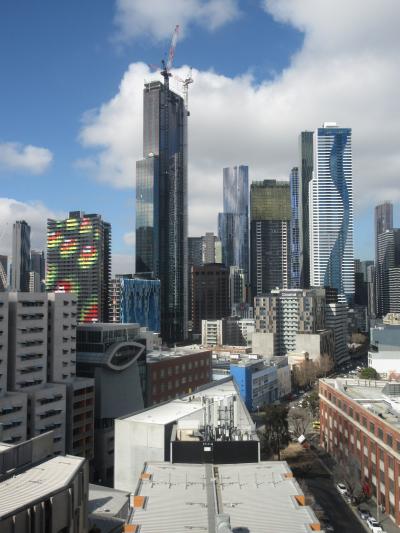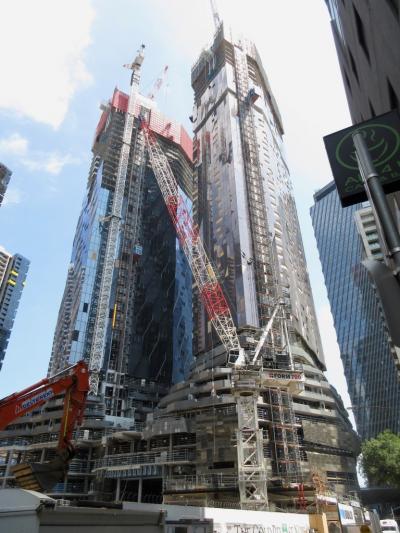New rectification powers and a statutory duty of care in NSW: a game changer for resident safety?
Dr Matthew Bell (m.bell@unimelb.edu.au) is a guest blogpost author from the Melbourne Law School. This post is an expanded and edited version of a piece by the author published by The Conversation on 12 June 2020. He previously wrote on Housing After Grenfell here.
Posted:
Time to read:
Three years have now passed since a façade cladding-fuelled fire at Grenfell Tower in London claimed 72 lives. The construction industry and its regulators around the world are still grappling with how to design an effective regulatory scheme for delivering apartment buildings which keep their occupants safe.

Apartment buildings in Melbourne, Australia.
Image owned by Matthew Bell
The first week of June saw the passage, through the Parliament of the Australian state of New South Wales, of the Design and Building Practitioners Bill 2020 (‘DBPB’) and the Residential Apartment Buildings (Compliance and Enforcement Powers) Bill 2020 (‘RABB’). When these Bills come into force over the next few months, they will insert several important pieces into NSW’s ‘jigsaw puzzle’ (as the state’s Better Regulation Minister has described it) of regulatory reform.
These include:
- extended practitioner registration requirements
- a statutory duty of care to protect homeowners against economic loss
- powers for the regulator to hold up occupancy of apartment buildings until serious defects are fixed, and to order rectification of such defects in existing buildings.
Having been criticised for dragging its feet on reforms, including by the withdrawal of the DBPB in November 2019, the passage of the Bills represents a rapid reaction by the NSW Government to the urgency called for on 30 April by the Final Report of the Legislative Council Public Accountability Committee (‘PAC’) into Regulation of Building Standards, Building Quality and Building Disputes. Indeed, the RABB was passed just two days after being introduced into the lower house.
The speed with which these measures made their way through Parliament means that it will take some time for their implications to be fully absorbed in NSW and beyond. And the Government is expected to fill in details of the schemes through Regulations.
Given the interest that they are likely to garner in other jurisdictions where building safety reform programs are underway or being considered, a brief summary of the duty of care and rectification powers is set out below.
Two points should be made at the outset.
The first is that, by being explicit that they are elements in a larger regulatory program, the Bills are consonant with the underlying need for holistic reform underpinning reports including Shergold-Weir’s 'Building Confidence' (Australia) and Hackitt’s 'Building a Safer Future' (UK). Thus, the Bills rest upon the six ‘pillars’ for reform which the NSW government has committed to: the regulatory framework, building ratings systems, skills and capabilities, procurement methods and contracts, digitisation (including, most recently, the potential for blockchain to reduce cashflow issues), and research.
The second is that the ambitious interventions the Bills represent bring into play an immutable law of building regulation: for every principled reform, there will be an opposing (and sometimes unequal) reaction by the status quo. The success of the Bills in achieving their desirable purpose of increasing confidence and protection for dwelling owners and occupants faces, therefore, a number of hurdles. These include the availability of insurance, liability pushback, and regulator capacity, as discussed briefly at the end. These challenges need to be anticipated not just in NSW but in any other jurisdiction seeking to implement similar measures.
Statutory duty of care
Part 4 of the DBPB imposes a duty on each ‘person who carries out construction work’ to ‘exercise reasonable care to avoid economic loss caused by defects’.

High-rise buildings in construction, in West Side Place, Melbourne, Australia
Image owned by Matthew Bell
The duty has been introduced to plug the liability gap at common law which was confirmed by the High Court of Australia in its Brookfield Multiplex judgment in 2014. This essentially endorsed, with effect across Australia, the restrictive approach to duties of care in negligence sounding in pure economic loss which has applied in England and Wales since Murphy v Brentwood District Council in 1991. The gap leaves owners, subsequent to the first owner who contracted with the builder and other project parties, without a right of action in negligence against those parties unless they can fit themselves within a narrow band of ‘salient features’ (primarily, that they are ‘vulnerable’ in the sense that they are unable reasonably to protect their interests via contract or as beneficiaries of warranties under state-based residential building legislation).
The new statutory duty is widely framed in the DBPB (primarily in s 37 and its definitions in s 36):
- ‘owners’ has an expansive definition, including freehold owners and owners of lots within strata schemes (a common form of ownership of apartments in Australia)
- owners corporations (which, essentially, represent apartment owners in relation to common property in the building) also may recover damages where they suffer economic loss (s 38)
- the ‘construction work’ to which the duty applies includes the manufacture and supply of building products
- the duty is owed regardless of whether the work was carried out under a contract
- the duty applies retrospectively (sch 1 cl 5), thereby extending to subsequent owners.
The duty cannot be delegated (s 39) or contracted out of (s 40).
There are restrictions on the scope of the duty. Its operation is subject to applicable limitation periods; primarily, the 10-year period under s 6.20 of the Environmental Planning and Assessment Act 1979 (NSW). And the Civil Liability Act 2002 (NSW) applies (s 41(3)): the detailed impact of this will no doubt be clarified as claims are brought before the courts, but it could lead to significant restrictions on liability. Finally, in his Second Reading Speech for the DBPB, the Minister has flagged that the types of buildings and work to which the duty applies will be limited in the forthcoming regulations.
New powers to order developers to rectify serious defects
The centrepiece of the RABB is its Part 5 Division 1. This provides an ability for the Secretary (likely to be delegated to the Building Commissioner) to order the correction of ‘serious defects’ in ‘residential apartment buildings’.
Under s 33, ‘building work rectification orders’ may be issued to developers (widely defined, including owners of the land) where the ‘Secretary has a reasonable belief that building work was or is being carried out in a manner that could result in a serious defect’.
For its part, the definition of ‘serious defect’ has several fairly broad gateways, including failure to comply with the performance requirements of the Building Code, defects likely to deny habitability or use of the building for its intended purpose, or the use of proscribed building products.
To make sure that these defects are rectified before residents take possession of their apartment, the Secretary can issue a ‘prohibition order’ to hold up issue of an occupation certificate (s 9). The preconditions to issue of the certificate also dovetail with other recent legislative requirements, including the developer’s obligation to provide a ‘defects bond’ for 2% of the contract price.
The retrospective (‘was’) aspect of the rectification regime is very significant: the Secretary’s powers may be exercised up to 10 years after issue of the issue of the occupation certificate (s 6(1)(b)).
Challenges to regulatory effectiveness
The Minister said that the Bill ‘reflects a new era in the industry and puts consumers first’. Despite this, many potential obstacles to success may be anticipated, especially as the seeds of the reforms are being sown in an industry landscape continuing to experience seismic shifts due to COVID-19. They include the following.

Premier Tower, in Melbourne, Australia
Image owned by Matthew Bell
Firstly, economically-viable insurance products need to be available to cover practitioner liability, including the retrospective liability anticipated by the statutory duty of care. This is a particular challenge in respect of retrospective liability for designers (and other professionals) and their insurers given the ‘claims made’ nature of professional indemnity insurance: at the very least, the need to anticipate such claims will add further pressure to increase premiums.
Second, it is an open question whether developers and parties throughout the contracting chain will be able to absorb the cost and time risk that an occupation certificate will be delayed by an order to correct serious defects. This raises, as Geoff Hanmer has pointed out, the prospect of insolvency and ‘phoenixing’ of developers, leaving building owners and residents in limbo. A further complication is that these matters are largely within the Federal, rather than state, legislative bailiwick in Australia, opening up a regulatory lacuna which is often exploited.
Third, will the regulator charged with administering the regime be adequately resourced to allow inspections – and, if necessary, prohibition and rectification orders – to be issued in a timely manner across the industry? The Commissioner has said that ‘we will be landing really hard on people who have had a historical record of not doing the right thing’, but cultural change demands more than just the eradication of a few ‘bad apples’. The lack of detail in the Bill about who will undertake inspection and enforcement is likely a function of the unresolved issue in NSW (as it is in the UK with the Building Safety Regulator) of whether the state will put in place a regulator with omnibus powers in relation to building standards, akin to the Queensland Building and Construction Commission and Victorian Building Authority (as has been recommended by the PAC).
Regardless of whether the Commissioner in fact ends up with a Commission under him, he and his colleagues will need rapidly to put in place the infrastructure necessary to roll out the extensive interventions which the Bills anticipate.
Not the end of the road for reform in NSW
The Minister and the Commissioner have made clear that the DBPB and RABB are by no means the last word in safety-related building reform in NSW. The Government is still working through the recommendations of the PAC, including that NSW consider a fund and specialised agency for façade cladding rectification along the lines put in place in its neighbouring state of Victoria a year ago.
Three years after Grenfell, however, it can at least be said that NSW is making a concerted attempt to design and build a holistic regulatory scheme to address the inherent tensions which make defects in the buildings we call ‘home’ inevitable.
__________
How to cite this blog post (Harvard style)
Bell, M. (2020). New rectification powers and a statutory duty of care in NSW: a game changer for resident safety? Available at: https://www.law.ox.ac.uk/housing-after-grenfell/blog/2020/06/new-rectification-powers-and-statutory-duty-care-nsw-game (Accessed [date])
Share:
